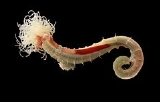
Terebellidae
Encyclopedia
Terebellidae is a family
of polychaete
worms. They are surface deposit feeders, catching falling particles with numerous elongate prostomial tentacles splayed out on the sea floor. These tentacles, which are the most or only normally visible portion of the animal and are reminiscent of spaghetti
, inspired the common name spaghetti worms. The remainder of the animal is in a semi-permanent burrow or permanent tube in soft substrates.
Most terebellids live in burrows or crevices and are often of large size, ranging up to 150 millimetres in length and 15 millimetres in width. The numerous, very long tentacles which radiate from near the mouth are used for finding and collecting food particles from the sediment surface. The tentacles are not retractable as is the case in the ampharetids
. They have plump anterior bodies and numerous segments in their long, tapered posterior bodies, whereas ampharetids are more compact. They have branched gills laterally on up to three anterior chaetigers but in the subfamily Thelepodinae the gills are numerous simple filaments. The mid-body chaetigers are in double rows in the subfamily Amphitritinae. In the subfamily Polycirrinae, the gills are absent and the prostomium is expanded as an undulating membrane which bears the tentacles.
are divided between many dozens of genera
. Most of these are assigned to 4 subfamilies. Some additional genera are of unresolved or quite basal position.
Family (biology)
In biological classification, family is* a taxonomic rank. Other well-known ranks are life, domain, kingdom, phylum, class, order, genus, and species, with family fitting between order and genus. As for the other well-known ranks, there is the option of an immediately lower rank, indicated by the...
of polychaete
Polychaete
The Polychaeta or polychaetes are a class of annelid worms, generally marine. Each body segment has a pair of fleshy protrusions called parapodia that bear many bristles, called chaetae, which are made of chitin. Indeed, polychaetes are sometimes referred to as bristle worms. More than 10,000...
worms. They are surface deposit feeders, catching falling particles with numerous elongate prostomial tentacles splayed out on the sea floor. These tentacles, which are the most or only normally visible portion of the animal and are reminiscent of spaghetti
Spaghetti
Spaghetti is a long, thin, cylindrical pasta of Italian origin. Spaghetti is made of semolina or flour and water. Italian dried spaghetti is made from durum wheat semolina, but outside of Italy it may be made with other kinds of flour...
, inspired the common name spaghetti worms. The remainder of the animal is in a semi-permanent burrow or permanent tube in soft substrates.
Most terebellids live in burrows or crevices and are often of large size, ranging up to 150 millimetres in length and 15 millimetres in width. The numerous, very long tentacles which radiate from near the mouth are used for finding and collecting food particles from the sediment surface. The tentacles are not retractable as is the case in the ampharetids
Ampharetidae
Ampharetidae are a family of terebellid "bristle worm" . As such, they belong to the order Canalipalpata, one of the three main clades of polychaetes. They appear to be most closely related to the peculiar alvinellids which inhabit the deep sea, and somewhat less closely to the well-known trumpet...
. They have plump anterior bodies and numerous segments in their long, tapered posterior bodies, whereas ampharetids are more compact. They have branched gills laterally on up to three anterior chaetigers but in the subfamily Thelepodinae the gills are numerous simple filaments. The mid-body chaetigers are in double rows in the subfamily Amphitritinae. In the subfamily Polycirrinae, the gills are absent and the prostomium is expanded as an undulating membrane which bears the tentacles.
Systematics
The roughly 400 known speciesSpecies
In biology, a species is one of the basic units of biological classification and a taxonomic rank. A species is often defined as a group of organisms capable of interbreeding and producing fertile offspring. While in many cases this definition is adequate, more precise or differing measures are...
are divided between many dozens of genera
Genera
Genera is a commercial operating system and development environment for Lisp machines developed by Symbolics. It is essentially a fork of an earlier operating system originating on the MIT AI Lab's Lisp machines which Symbolics had used in common with LMI and Texas Instruments...
. Most of these are assigned to 4 subfamilies. Some additional genera are of unresolved or quite basal position.
- Basal or incertae sedisIncertae sedis, is a term used to define a taxonomic group where its broader relationships are unknown or undefined. Uncertainty at specific taxonomic levels is attributed by , , and similar terms.-Examples:*The fossil plant Paradinandra suecica could not be assigned to any...
- Genus Amphitrite
- Genus Athelepus
- Genus Dendrobranchus
- Genus Ehlersiella
- Genus Morgana
- Genus Odysseus
- Genus Paraeupolymnia
- Genus Terebellodibranchia
- Genus Tyira
- Genus Uncinochaeta
- Subfamily Amphitritinae
- Subfamily Artacaminae
- Subfamily Polycirrinae
- Subfamily Thelepodinae

